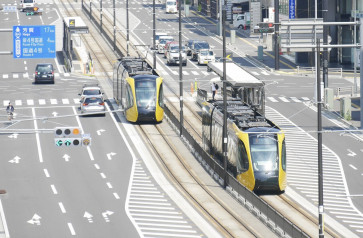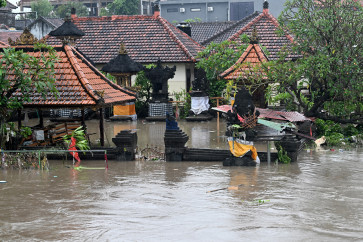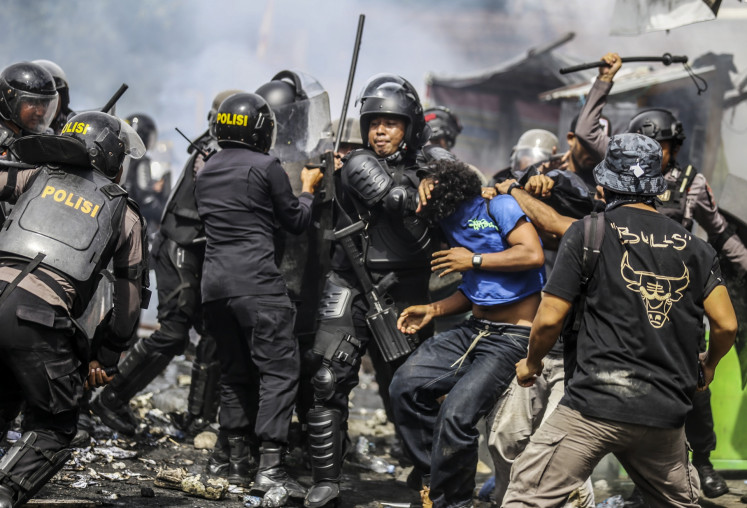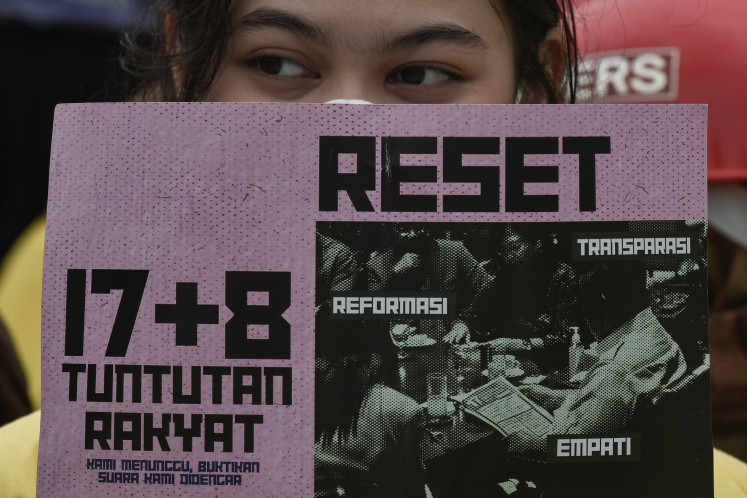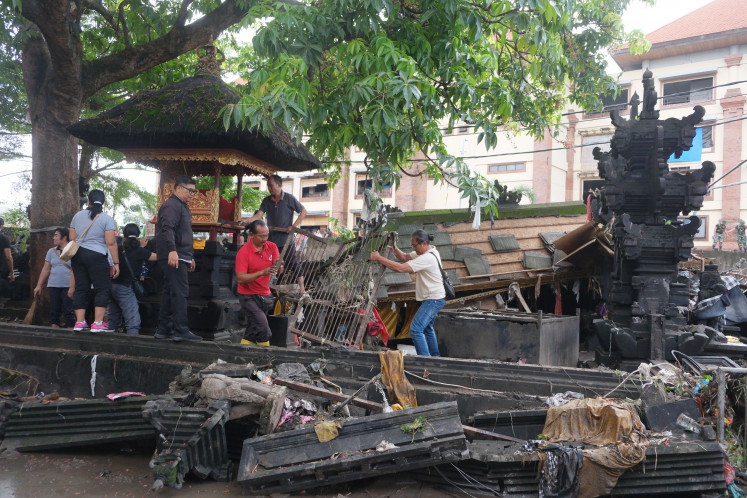Popular Reads
Top Results
Can't find what you're looking for?
View all search resultsPopular Reads
Top Results
Can't find what you're looking for?
View all search resultsQuick response to volcanic activity
The 1,731-meter Mount Kelud volcano in East Java erupted suddenly on Thursday night, releasing smoke and ash 12-17 kilometers into the air, and triggering pyroclastic flows and showers of gravel and ash, which travelled by wind to Surabaya (some 100 km away), Pamekasan, Madura (300 km), all in East Java; Yogyakarta (400 km) and Bandung (+550km) in West Java
Change text size
Gift Premium Articles
to Anyone
T
he 1,731-meter Mount Kelud volcano in East Java erupted suddenly on Thursday night, releasing smoke and ash 12-17 kilometers into the air, and triggering pyroclastic flows and showers of gravel and ash, which travelled by wind to Surabaya (some 100 km away), Pamekasan, Madura (300 km), all in East Java; Yogyakarta (400 km) and Bandung (+550km) in West Java. The disruption of flights and closure of seven airports lasted some 72 hours.
The ash fall reaching cities hundreds of kilometers away may still affect millions of people in densely populated Java, ranging from respiratory infections, to traffic accidents, and the death of livestock from respiratory problems.
Two days before his visit President Susilo Bambang Yudhoyono instructed officials to ensure total evacuation of the estimated 60,000 people within a 10-km radius of the danger zone around Kelud.
Did the central and local government anticipate the scale of the present events? Probably not, as the government was most likely preparing for a lower scale of eruption, indicated by the defined danger zone of 10 km.
The Volcano and Geological Disaster Mitigation Center (PVMBG) indirectly apologized, citing the changing behavior of Kelud since 2007. It argued that the 2014 explosion 'is similar to the 1990's and previous years' disasters'.
However scientists say Kelud is often characterized by its short duration of alerts, but is often extremely violent. The 2007 eruption was considered an anomaly because it was the first non-explosive eruption since the first recorded eruption in the year 1000.
Nearby regency and municipality governments such as Kediri, Blitar, Malang, Mojokerto and Surabaya had no local disaster-management agency in place.
The East Java Disaster Mitigation Agency (BPBD Jatim) as well as the National Disaster Mitigation Agency (BNPB) frequently pushed the local governments to establish local disaster-management agencies through bylaws.
In the event of any failure in preparedness, the higher authorities could easily scapegoat the local governments which were reluctant to allocate resources to establish the necessary institutions.
Actually, the eruption of Kelud has been anticipated since the colonial period as well as by the central and local governments, mainly to avoid 'secondary hazards' or potential side effects which could trigger a giant hydrological disaster through the crater's lake formed from previous eruptions.
Heavy rains may collapse the crater lake, estimated to comprise tens of millions of cubic feet of water and may trigger lava flows channeled through the rivers in densely populated areas, such as the town of Blitar. Now with an estimated population of 130,000, Blitar had been buried by rapid lava flow following the May 1919 eruption, which killed more than 5,000 people.
The task of governing the risk of volcanoes in Indonesia is held by different levels of authority and agencies. The volcano monitoring, prediction and continuous early-warning service is the responsibility of the PVMBG, tasked with communicating the level of danger and risks.
The humanitarian response is the shared responsibility of local and national disaster-management agencies, while responsibility for post-disaster recovery is spread widely among various sectors and levels of governance.
While for 24 hours the central government delayed declaring emergency status, Yogyakarta Governor Hamengku Buwono issued a seven-day emergency status less than 24 hours after the ash covered his province. Emergency status is the legal and necessary step for a local government to mobilize resources to tackle a humanitarian emergency within the first week.
France-based scientists Ãdouard De Bélizal and Franck Lavigne conducted interviews with nine disaster-management teams and a community survey to understand preparedness levels.
Their paper in the Geomorphology journal in 2012 highlights the confusion among communities either facing and managing risk and crisis situations, or living with them.
They also cited classic problems such as a 'lack of communication and information' in disaster management following an eruption.
Based on the 2007 experience, the approach of the Army and the police in the Kelud eruption has been one of policing, which is intimidating, rather than building trust to encourage voluntary evacuation.
For a better response to future crises, the government should first promptly establish a national command system normally placed at the office of the national disaster body, the BNPB, as soon as the event occurs.
As the ash travels through different provinces, the regional command system can be established with clear lines of command as exemplified by the Yogyakarta Governor.
Second, there should be consistency in leadership response to every large emergency ' the public questioned why the President rapidly responded to the Kelud eruption in Java compared to the Sinabung eruptions from September 2013 to January 2014 in North Sumatra.
Third, given the costs associated with the establishment of a local disaster-management agency ' between Rp 1.5 billion (US$ 127,356) and Rp 2.5 billion to run a BPBD office ' Jakarta should create incentives such as grants and funding that can be accessed without waiting for a disaster to occur.
Some 100 regencies and municipalities with no recent memory of disasters have not established local disaster agencies.
Fourth, given the uncertainty of eruptions, the PVMBG needs to correct its style of risk communication to one that can be properly translated into better preparedness and response, and reduce the surprises arising from inaccurate information.
Finally, without waiting for international agencies such as the World Bank, Jakarta can lead a systematic study of loss and damage as well as the direct benefits of the eruption to agriculture.
For instance, given the widespread ash falls, can Javanese farmers reduce dependency on chemical fertilizers? If yes, how much money can farmers save from the released minerals?
In addition, as farmers in Central and East Java are closely connected to international food-supply chains, what can be done by the government to ensure their early recovery? This study is vital to collect new information concerning risk and benefit from this type of eruption.
The writer is a research fellow with the Centre for Non-Traditional Security at the S. Rajaratnam School of International Studies (RSIS), Nanyang Technological University in Singapore.



